Common menu bar links
Breadcrumb Trail
ARCHIVED - Library and Archives Canada
 This page has been archived.
This page has been archived.
Archived Content
Information identified as archived on the Web is for reference, research or recordkeeping purposes. It has not been altered or updated after the date of archiving. Web pages that are archived on the Web are not subject to the Government of Canada Web Standards. As per the Communications Policy of the Government of Canada, you can request alternate formats on the "Contact Us" page.
Minister's Message

The Canadian Heritage portfolio gives Canadians the opportunity to participate in society, to achieve their full potential, and to celebrate their heritage and their culture. As a departmental agency, Library and Archives Canada (LAC) is working to achieve this goal.
Library and Archives Canada is the cornerstone of our country's collective memory. It preserves documentary sources that bolster our understanding of Canadian history and our democratic society across time. All forms of information-books, brochures, newspapers, government records, photographs, films, maps, music, and a rapidly growing collection of digital items in diverse formats-enable us to interact with the past, take stock of the present, learn from our successes and our failures, celebrate our identities, and plan our future.
LAC is taking action in many areas that are very relevant to our government's priorities. The role that LAC plays in modernizing Government of Canada recordkeeping enables our Government to be accountable to Canadians for sound and effective government management. LAC's commitments to reach out to all Canadians through innovative programs and services and to build a collection that reflects the diversity of contemporary Canadian society are consistent with our Government's focus on core activities that align with the interests and priorities of our citizens.
As Minister of Canadian Heritage and Official Languages, I invite you to read the Report on Plans and Priorities for 2009-2010 prepared by Library and Archives Canada. This report shows LAC's commitment to ensuring that the creativity and innovation of Canadian society contribute not only to our cultural vitality, but also to our future.
The Honourable James Moore
Section I - Department Overview
1.1 Summary Information
The preamble of the Library and Archives of Canada Act states that the mandate of Library and Archives Canada (LAC) is:
- to preserve the documentary heritage of Canada for the benefit of present and future generations;
- to serve as a source of enduring knowledge accessible to all, contributing to the cultural, social and economic advancement of Canada as a free and democratic society;
- to facilitate in Canada cooperation among the communities involved in the acquisition, preservation and diffusion of knowledge; and
- to serve as the continuing memory of the government of Canada and its institutions.
As noted above, the Library and Archives of Canada Act establishes an ambitious, wide-ranging mandate related to the acquisition, preservation and making known of Canada's collective memory. Through a continuing multi-year process across LAC, we have been consolidating and focusing our efforts on the core activities most relevant to our mandate and to the interests of Canadians. Consistent with the government-wide priorities announced in the 2008 Speech from the Throne to ensure sound budgeting and make government more effective, we are applying a strategic perspective to our mandate, evaluating our processes and rethinking our practices to get the best results from our resources. Those steps are enabling us to become a knowledge institution fully in line with changing information environment in Canada and worldwide.
Our strategies are enabling LAC to address the issue with the most influence on our responsibilities: the way that digital technologies are reshaping the world's information environment. Canada's collective memory is increasingly created in digital form and made available in formats driven by new technologies and media (electronic publications, websites, DVDs, etc.). This is changing what we acquire, preserve and make known. The Internet has changed the way in which people get information. Canadians expect to explore the LAC collection online from their homes, schools, libraries and workplaces - whether the items in the collection were "born digital" or are printed materials, photographs, maps, documentary art such as posters and paintings or any of the many other types of items we hold for Canadians.
There are three main sources for the material in Canada's collection, regardless of format. First, legislated requirements obligate publishers to provide copies of materials published in Canada (legal deposit). Second, Government of Canada departments and agencies transfer to us their documents and records of expected business or historic value. Third, we receive donations of many materials, while purchasing others and gathering many more materials directly from the Internet.
Regardless of format, LAC manages the care of this priceless collection in ways that preserve items for future generations. To make it easier for Canadians to discover the collection, LAC describes holdings in accordance with national and international standards and is constantly exploring ways to make information resources more accessible. On behalf of the Canadian archival and library communities, LAC plays a leadership role in the development and maintenance of professional standards that make access to collections more simple and consistent for Canadians.
Library and Archives Canada: Building Canada's Collective Memory and Making it Accessible to Canadians
- 20 million books, periodicals, newspapers, microfilms, literary texts and government publications
- 167,000 metres of government and private textual records
- 3 million architectural drawings, maps and plans
- 24 million photographs
- 350,000 hours of film, video and sound recordings
- Canada's portrait collection, which includes 20,000 works of art and thousands of caricatures
- 547,000 musical items
- 365,000 items from the documentary art collection, including watercolours, sketches, miniatures and oil paintings
- More than a billion megabytes of digital content
- 17.8 million visitors to www.collectionscanada.gc.ca in 2007
- 138.1 million page views on the www.collectionscanada.gc.ca website
- 41,000 visitors to LAC locations took part in events in 2007-08
Source: Library and Archives Canada
Our responsibilities for the management of Government of Canada digital, paper and other records support government accountability and decision making. They enable researchers and citizens to explore government actions of the past, while our eight Regional Service Centres manage more contemporary records in all media on behalf of more than 90 federal government organizations across the country. In the event of disaster or emergency in a government department or agency, the Centres hold backup copies of electronic records that would be essential to operations and the protection of rights. More broadly, we lead the examination of government recordkeeping issues and advise on improvements to help meet government priorities and to make federal records more accessible.
We seek to make our entire collection known in many ways, based increasingly on client needs. The Library and Archives Canada website has become a major destination for Canadians and people interested in Canada. (www.collectionscanada.gc.ca/collection/index-e.html) (see Figure 1) Our staff members organize exhibitions and learning events that take place in LAC facilities and at partner sites across Canada. We help users understand how our collection and resources are organized and assist them in their searches (see Figure 2). As necessary, we safeguard the rights attached to holdings, such as copyrights and privacy protection. LAC Access to Information responsibilities often involve reviews of archival records, personnel records of former civilian and military government employees and our operational records.
Figure 1: Growing Demand for LAC Web Content
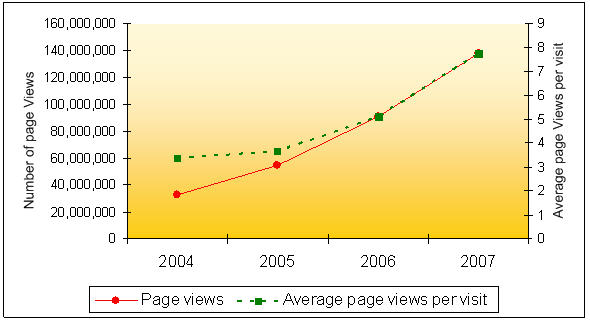
Source: Library and Archives Canada
| 2004 | 2005 | 2006 | 2007 | |
|---|---|---|---|---|
| Number of page views | 32,370,102 | 54,302,915 | 90,814,804 | 138,097,494 |
| Average page views per visit | 3.39 | 3.66 | 5.1 | 7.77 |
LAC works in partnership with libraries and archival institutions across the country. We share items and help other Canadian libraries and archives to share resources. This is augmented by our coordination of the library services of federal departments and agencies. Our National Archival Development Program supports archives across Canada as they work to preserve and make available the portions of Canada's collective memory in their own collections.
Figure 2: Types of Requests from Canadians received by LAC in 2007-08
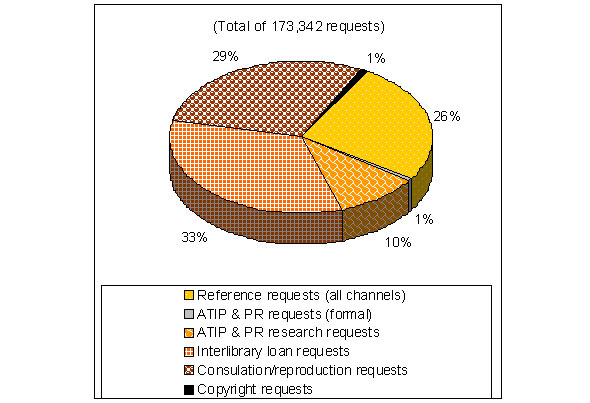
Source: Library and Archives Canada
| Types of requests | Proportion of Requests |
|---|---|
| Reference requests (all channels) | 26% |
| ATIP & PR requests (formal) | 1% |
| ATIP & PR research requests | 10% |
| Interlibrary loan requests | 33% |
| Consulation/reproduction requests | 29% |
| Copyright requests | 1% |
| Total | 173,342 |
Reference requests: Clients can make requests for information or to locate records in Reference Services (which includes the Canadian Genealogy Centre) by various channels including telephone, post, email, the LAC website and in-person.
ATIP & PR requests: Formal requests to consult restricted government records (subject to the Access to Information Act and the Privacy Act) are handled by Access to Information, Privacy and Personnel Records (ATIP&PR).
ATIP & PR research requests: ATIP & PR also offers an informal research service for personnel records of former government employees, military records, etc.
Interlibrary loan requests: Interlibrary Loans processes requests from Canadian libraries or archives to borrow published documents, photocopies or microfilms from our documentary heritage collection.
Consultation/reproduction requests: Clients can also request a reproduction (photocopies, photo or digital format) of documents from the collection.
Copyright requests: The Copyright Office provides permission to reproduce Crown or LAC material and information on third party licences.
This chart shows our program activity architecture (PAA). It illustrates our major activities and the key elements of each that enable us to work towards our main objective. The PAA is mainly related to the Government of Canada priority called "Social Affairs" and more specifically to the component "A Vibrant Canadian Culture and Heritage".
Figure 3: LAC Program Activity Architecture
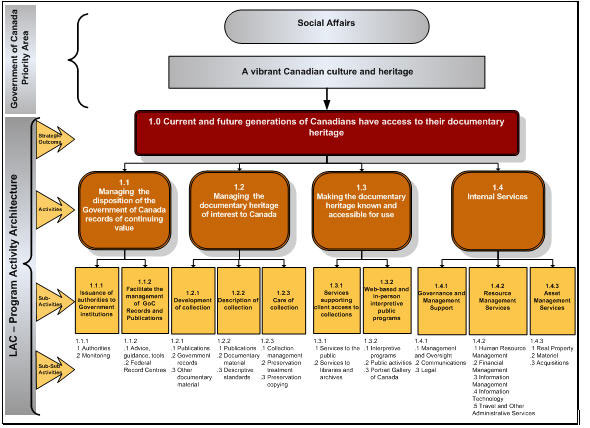
Source: Library and Archives Canada
Governement of Canada Priority Area
Social Affairs
A Vibrant Canadian Culture and Heritage
LAC Program Activity Architecture
Strategic Outcome
1.0 Current and future generations of Canadians have access to their documentary heritage
Activities
1.1 Managing the disposition of the Government of Canada records of continuing value
Sub-Activities
1.1.1 Issuance of authorities to government institutions
Sub-Sub Activities
1.1.1
.1 Authorities
.2 Monitoring
Sub-Activities
1.1.2 Facilitate the management of GoC Records and Publications
Sub-Sub Activities
1.1.2
.1 Advice, guidance, tools
.2 Federal Record Centres
Activities
1.2 Managing the documentary heritage of interest to Canada
Sub-Activities
1.2.1 Development of collection
Sub-Sub Activities
1.2.1
.1 Publications
.2 Government records
.3 Other documentary material
Sub-Activities
1.2.2 Description of collection
Sub-Sub Activities
1.2.2
.1 Publications
.2 Documentary material
.3 Descriptive standards
Sub-Activities
1.2.3 Care of collection
Sub-Sub Activities
1.2.3
.1 Collection management
.2 Preservation treatment
.3 Preservation copying
Activities
1.3 Making the documentary heritage known and accessible for use
Sub-Activities
1.3.1 Services supporting client access to collections
Sub-Sub Activities
1.3.1
.1 Services to the public
.2 Services to libraries and archives
Sub-Activities
1.3.2 Web-based and in-person interpretive public programs
Sub-Sub Activities
1.3.2
.1 Interpretive programs
.2 Public activities
.3 Portrait Gallery of Canada
Activities
1.4 Internal Services
Sub-Activities
1.4.1 Government and Management Support
Sub-Sub Activities
1.4.1
.1 Management and Oversight
.2 Communications
.3 Legal
Sub-Activities 1.4.2 Resource Management Services
Sub-Sub Activities
1.4.2
.1 Human Resource Management
.2 Financial Management
.3 Information Management
.4 Information Technology
.5 Travel and Other Administrative Services
Sub-Activities
1.4.3 Asset Management Services
Sub-Sub Activities
1.4.3
.1 Real Property
.2 Material
.3 Acquisitions
Source: Library and Archives Canada
Note:
1- Federal Record Centres are now called Regional Service Centres
2- Effective recordkeeping establishes an essential administrative and business foundation within government for services to Canadians. It is an essential element in supporting ministerial and managerial accountability within Canada's democratic process. Therefore, part of program activity 1.1 also relates to Government Affairs.
1.2 Planning Summary
Financial Resources ($ thousands)
| 2009-10 | 2010-11 | 2011-12 |
|---|---|---|
| 121,338.9 | 128,359.9 | 102,421.9 |
Note: Please refer to the Expenditure Profile for explanations on spending trends.
Human Resources (Full-Time Equivalents - FTEs)
| 2009-10 | 2010-11 | 2011-12 |
|---|---|---|
| 1,132 | 1,109 | 1,109 |
Program Activities by Strategic Outcome
| Strategic Outcome 1: Current and future generations of Canadians have access to their documentary heritage. | |||||
|---|---|---|---|---|---|
| Performance Indicators Narrative (Preservation, growth of the collection, accessibility) |
Targets In development |
||||
| Program Activity | Forecast Spending ($ thousands) |
Planned Spending ($ thousands) |
Alignment to Government of Canada Outcomes |
||
| 2008-09 | 2009-10 | 2010-11 | 2011-12 | ||
| Program Activity 1.1 - Managing the disposition of the Government of Canada records of continuing value | 13,434.1 | 9,860.7 | 9,832.7 | 9,801.7 | Government Affairs |
| Program Activity 1.2 - Managing the documentary heritage of interest to Canada | 65,851.7 | 57,287.8 | 66,861.8 | 41,855.8 | Vibrant Canadian Culture and Heritage |
| Program Activity 1.3 - Making the documentary heritage known and accessible for use | 42,384.0 | 24,612.0 | 22,170.0 | 21,360.0 | Vibrant Canadian Culture and Heritage |
| Program Activity 1.4 - Internal Services | Note 1 | 29,578.4 | 29,495.4 | 29,404.4 | |
| Total | 121,669.8 | 121,338.9 | 128,359.9 | 102,421.9 | |
Notes:
- The Internal Services program activity becomes effective 2009-10, to encompass all corporate services related activities. In prior years, corporate services activities were allocated between the institution's existing program activities. The corporate services amounts that were allocated are as follows: $2.3M Managing the Disposition of the Government of Canada Records of Continuing Value, $14.6M Managing the documentary heritage of interest to Canada, and $12.9M Making the documentary heritage known and accessible for use.
- For 2008-09, the variance between the Forecasted Spending of $121.7M and the Main Estimates of $157.6M, shown in the Voted and Statutory Items table on page 16, is mainly attributed to a decrease of $29M in funding for the construction of a building to house the public programming and exhibitions of the Portrait Gallery of Canada. The Government announced on November 7, 2008, the termination of the selection process and decided not to pursue this project further at this time. In addition, $6.8M of the Interim Collection Facility project funding was reprofiled to 2010-11 to meet the cashflow requirements.
- Please refer to the Expenditure Profile for explanations on spending trends.
Parliament created Library and Archives Canada (LAC) in 2004. It recognized that Canada requires a federal knowledge institution to serve as a focal point for building Canada's collective memory and making it known, including through collaboration with the many other provincial, territorial, local and specialized knowledge institutions that are LAC's partners. At the time, LAC articulated a vision for the new institution that captured key factors influencing our strategic outcome (www.collectionscanada.gc.ca/about-us/016/index-e.html). In 2006, LAC adopted a Strategic Framework that sets out the five priorities, or strategic directions, listed in the table at the end of this discussion. They are discussed in greater detail in the LAC Business Plan 2008-2011 and signal that LAC is in the process of addressing its core activities differently. (www.collectionscanada.gc.ca/about-us/012-301-e.html)
As a government knowledge institution, LAC adapts to a rapidly evolving information environment to address the needs of Canadians and people interested in the story of Canada. At the core of that rapid evolution is the impact of digital technologies on every aspect of the work of LAC and other knowledge institutions. It has been estimated that with the rapid expansion of technologies such as digital cameras and surveillance equipment, as well as data being collected in applications such as databases that the amount of digital information is growing by 60 per cent per year. (www.emc.com/about/emc-at-glance/annual-overview/2008/h4182-2008-annual-overview.pdf) That development alone underlines a larger LAC recognition that we must work strategically and with an eye to engaging partners who are also committed to building and making known Canada's collective memory.
We have been contributing to international initiatives and learning from our counterparts in other countries to determine how best to move forward - both to acquire and preserve digital records, most of which are only available in non-print format, and how to make that growing part of Canada's collective memory known. At the same time, LAC continues to devote significant resources to our ongoing responsibilities for the portions of the collection that are in traditional formats such as print, sound recordings, portraits and film, all of which call on the specialized expertise for which LAC is known.
A key element of this approach is a much greater use of interdisciplinary methods that go beyond the traditional ways that library and archival professionals address their work. The approach also encourages LAC to look outward to partners, current or potential, and to become more client-centred. The commitment to partnerships has already begun to pay dividends. For example, we have worked closely with departments and agencies across the Government of Canada to identify and act on priorities to modernize government recordkeeping to support accountability and effective government operations. This initiative originated in 2006 with the ADM Task Force on Recordkeeping, which was created to address the government-wide challenges of recordkeeping raised by the Auditor General in her November 2003 report, Protection of Cultural Heritage in the Federal Government. In collaboration with Treasury Board Secretariat (Chief Information Officer Branch), LAC has provided expertise and support to develop the Recordkeeping Directive. When implemented as an element of the Government of Canada's Policy on Information Management, the directive will provide federal departments with standards, improved information management capacity, assessment tools and litigation guidelines.
In 2009-10, LAC will also seek to leverage partnerships with museums and galleries across Canada as it follows up on the commitment of the Minister of Canadian Heritage and Official Languages to increase access to Canada's portrait collection.
Contribution of Priorities to Our Strategic Outcome
Operational Priorities
| Operational Priorities | Type | Description |
|---|---|---|
| LAC will adjust all aspects of its activities to adapt to the needs and benefit from the opportunities of the digital information environment | Ongoing (Note 1) |
High-level results:
Some 2009-10 actions:
|
| LAC will increase the relevance and accessibility of LAC collection and expertise to Canadians outside the National Capital Region (NCR) | Ongoing |
High-level result:
Some 2009-10 actions:
|
| LAC will focus its role in Government of Canada information management on the development of effective recordkeeping | Ongoing |
High-level result:
2009-10 action:
|
| LAC will make systematic use of collaborative arrangements and will increasingly deliver on its mandate through or with others | Ongoing |
High-level result:
2009-10 action:
|
| LAC will ensure citizen / client research and evaluation results are built into management decision making | Ongoing |
High-level result:
2009-10 action:
|
Note 1 - An ongoing priority is defined as one that is committed to at least three fiscal years prior to the subject year of the report.
The actions under the five priorities above have led us to implement a series of initiatives that would enhance interdisciplinary and collaborative work for all sectors of the institution including acquisition, preservation, description, professional competencies, infrastructure and enabling functions. The actions will be guided by the needs and perspective of clients, stakeholders and current or potential partners both in Canada and internationally. They will also have a significant impact on:
- Documentation Acquisition - We will develop an approach for integrated documentation to guide, coordinate and articulate organizational decisions and interventions engaged on behalf of government to identify, select and preserve Canada's documentary heritage.
- Preservation - We will determine how best to capture Canada's documentary heritage in digital formats, while preserving items in all media in our collection.
- Resource Discovery - We will determine how best to describe the vast LAC collection in ways that make Canadians' discovery of the resources in our collection timely, affordable, accurate and user-friendly.
Management Priorities
Actions under the five priorities will also impact the way we do business in other areas of LAC. For example,
- We will use partnerships more strategically and creatively
- We will align our infrastructure, including our information technologies, with the needs of an increasingly digitally driven LAC and the needs of the Canadians who use the collection.
- We will focus internal services to support the realization of LAC priorities.
- We will draw on the skills and expertise of LAC staff in new ways and will support them as the expectations of LAC and Canadians evolve.
Library and Archives Canada evolves in a rapidly changing environment and the priorities set out above have been developed on the basis of a comprehensive risk analysis. We have taken into account issues such as the financial pressures facing the Government of Canada and risks related to the technologies we use or will introduce, the infrastructure we operate and the skilled human resources on which we rely to deliver results for Canadians.
Above all, we have set priorities in order to best respond to the challenges of a digital information world. Canadians increasingly expect to gain access to the LAC collection online, no matter what its original format was, even as demand continues in our traditional service channels. More information, including government information, is now born digital, such as websites or emails, while the array of non-digital items we collect or could add also continues to grow, which creates challenges for our collection development, documentation and preservation activities.
In the 2008-09 RPP (www.tbs-sct.gc.ca/rpp/2008-2009/inst/bal/bal00-eng.asp), LAC identified five areas of risk that it must manage as a collective memory institution. From these, four are directly related to this specific context of the changing environment in which we work. The dual challenges of preserving both old and new media - analog and digital heritage - continue to be the primary focus of the institution. Long-term preservation capacity is a challenge for all institutions in this evolving and demanding environment. We are working with our colleagues across Canada, across government and across the globe seeking innovative approaches to these challenges. As we renew our workforce, we will be seeking new employees and managers who can work and manage in this evolving complex environment, thereby combining new and traditional competences with the ability to bring continued innovation to the institution so as to address the leadership and capacity challenges of the 21st century.
In 2009-10, the five priorities that we continue to pursue have been developed to focus LAC resources on the core activities aligned with a changing documentary heritage environment that best serve Canadians. We are emphasizing investments that will take us furthest in the direction we are going, and accepting the most suitable trade-offs as we move the needed funds from other activities. We are addressing technology and infrastructure risks involved in managing an increasingly digital collection, while continuing the ongoing preservation capacity for our priceless collection in all formats. We are pursuing human resource strategies to ensure that our staff will be comfortable in a broader range of professional areas as our work culture shifts and we manage the transition arising from the large number of expected retirements in the years ahead.
Library and Archives Canada permanent funding has remained constant at approximately $100 million per fiscal year over the past four years. While we have experienced growth in our permanent funding for items such as, supporting our increased workload resulting from the implementation of the Federal Accountability Act, we have equally contributed on a permanent basis to government-wide initiatives to relocate spending to higher priorities of government, which results in the appearance of our permanent funding remaining stable. Library and Archives Canada's spending trend beyond our $100 million permanent funding is related to specific projects for which we have received temporary funding. The spending fluctuation, illustrated in Figure 4, is mainly explained by the following temporary projects:
- Between 2005-06 and 2008-09, we received approximately $20 million from the Department of Canadian Heritage in support of collaborative activities to advance the creation of cultural content online and other digitization projects (Canadian Culture Online program);
- Over three years beginning in 2007-08, we are receiving $21.7 million to replace obsolete systems and provide the capacity for managing electronic publications and the digital records of the Government of Canada; and
- In 2008-09, we received approval for the construction of a preservation facility that will safeguard Canada's cellulose nitrate-based documentary heritage (photographs and films). We anticipate spending $12.5 million in 2009-10 and an additional $1.5 million the following year. Planned spending includes $24.1 million until 2010-11 for the improvement of LAC's storage infrastructure capacity1. These projects reflect the element of the LAC mandate to safeguard and preserve Canada's documentary heritage. They respond to the need for us to have the preservation capacity to keep up with the constant growth of the documentary heritage of Canadians.
Library and Archives Canada is committed to prudent spending and ensuring measurable results are attained for Canadians. We work in close collaboration with other government departments and external partners to ensure the economic and effective delivery of our activities and to provide increased access to the collection.
1 Note that this funding is not yet finalized and that further details will be provided in the DPR and future RPPs.
Figure 4: Department Spending Trend
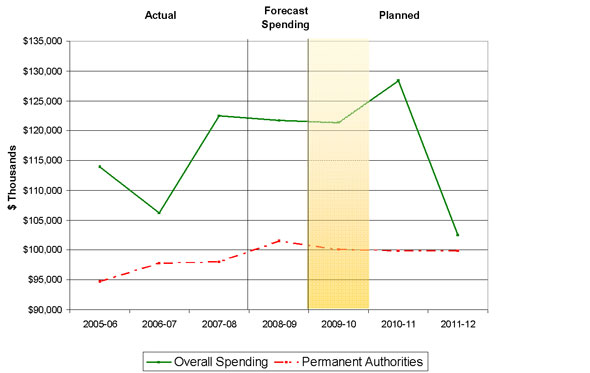
Source: Library and Archives Canada
| Fiscal Years |
Actual Spending | Forecast Spending | Planned Spending | Permanent Authorities |
|---|---|---|---|---|
| Overall Spending | ||||
| 2005-06 | 113,900,300 | 94,744,000 | ||
| 2006-07 | 106,166,000 | 97,712,000 | ||
| 2007-08 | 122,456,000 | 97,951,000 | ||
| 2008-09 | 121,669,800 | 101,495,000 | ||
| 2009-10 | 128,138,900 | 99,999,000 | ||
| 2010-11 | 121,559,900 | 99,792,000 | ||
| 2011-12 | 102,421,900 | 99,781,000 | ||
The pie chart displays the allocation of Library and Archives Canada by program activity. The funding is primarily allocated to Program Activity 1.2 for the development and description of the collection, and its preservation for Canada's future generations. Planned spending in 2009-10 for this program activity includes investments of $19.3 million for the capital projects described in the expenditure profile section.
Figure 5: 2009-10 Planned Spending by Program Activity ($ thousands)
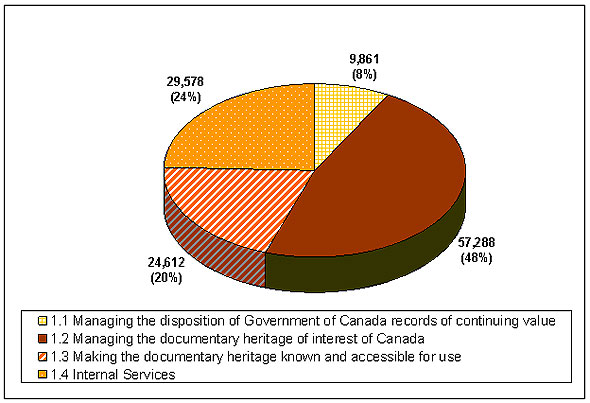
Source: Library and Archives Canada
| Program Activities | Planned Spending ($ thousands) |
Proportion by Program Activities |
|---|---|---|
| 1.1 Managing the disposition of Government of Canada records of continuing value | 9,861 | 8% |
| 1.2 Managing the documentary heritage of interest of Canada | 64,088 | 48% |
| 1.3 Making the documentary heritage known and accessible for use | 24,612 | 20% |
| 1.4 Internal Services | 29,578 | 24% |
It should be noted that Library and Archives Canada has a yearly internal process where it re-evaluates funding of program activities and as appropriate reallocates funding based on strategic priorities.
Voted and Statutory Items
($ thousands)
| Vote # or Statutory Item (S) |
Truncated Vote or Statutory Wording |
2008-09 Main Estimates ($ thousands) |
2009-10 Main Estimates ($ thousands) |
|---|---|---|---|
| 50 | Program expenditures | 145,749.0 | 110,216.0 |
| (S) | Contributions to employee benefit plans | 11,853.0 | 11,167.0 |
| Total | 157,602.0 | 121,383.0 |
Note: Please refer to the Expenditure Profile for explanations on spending trends.
